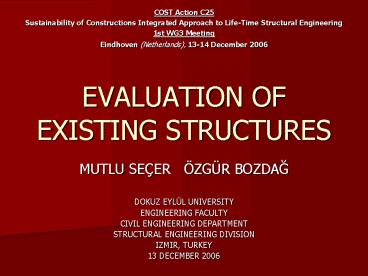EVALUATION OF EXISTING STRUCTURES - PowerPoint PPT Presentation
1 / 25
Title:
EVALUATION OF EXISTING STRUCTURES
Description:
Investigation of The New Constructions Built in Historic Centers ... Our country is located on one of the most active earthquake areas on earth. ... – PowerPoint PPT presentation
Number of Views:221
Avg rating:3.0/5.0
Title: EVALUATION OF EXISTING STRUCTURES
1
EVALUATION OF EXISTING STRUCTURES
COST Action C25 Sustainability of Constructions
Integrated Approach to Life-Time Structural
Engineering 1st WG3 Meeting Eindhoven
(Netherlands), 13-14 December 2006
- MUTLU SEÇER ÖZGÜR BOZDAG
- DOKUZ EYLÜL UNIVERSITY
- ENGINEERING FACULTY
- CIVIL ENGINEERING DEPARTMENT
- STRUCTURAL ENGINEERING DIVISION
- IZMIR, TURKEY
- 13 DECEMBER 2006
2
- Background and Expertise on WG3/WP9
- Mutlu SEÇER, M.Sc. (TR)
- M.Sc. Thesis Nonlinear Analysis Methods of
Steel Structures - Ph.D. Thesis (On going study) Investigation of
Stress Strain Time Relationships in Framed
Structures - Special Interests
- Second Order Analysis Techniques in Steel Frames
- Analysis of Semi Rigid Connections in Steel
Frames - Analysis of Imperfections
- Stability of Structures
- Practical Advanced Analysis Methods
- Performance Based Analysis of Structures
3
- Background and Expertise on WG3/WP9
- Özgür BOZDAG, M.Sc. (TR)
- M.Sc. Thesis Dynamic Analysis of Retaining
Structures - Ph.D. Thesis (On going study) Energy Based
Performance Anaysis of Structures - Special Interests
- Performance Based Analysis of RC Structures
- Earthquake Engineering and Structural Dynamics
- Soil Structure Interaction
- Rehabiliation of Masonry Structures
4
- Ongoing research activity at the national level
on the topic of WG3 - TUBITAK Project
- Sustainability of Constructions
- The Aim of the Study is
- Investigation of The New Constructions Built in
Historic Centers - (In The Meaning of Sustainability of The
Characteristics of Present Urban Form)
5
- Special Interests in WP of the WG3
- WP9 Monitoring of life-cycle performance
- Maintenance, repair and rehabilitation techniques
and planning - Guidelines for the planning of Maintenance,
Repair and Rehabilitation - Survey and condition assessment of structures
(safety and functionality) - Guidelines survey and condition assessment of
structures
6
INTRODUCTION
- Our country is located on one of the most active
earthquake areas on earth. Nearly 95 of Turkey
is on very risky seismic zones. Therefore
high-magnitude earthquakes commonly occur in
Turkey. The structures suffer a very high amount
of damage during these seismic activities and
earthquakes cause widespread destruction. - Major seismic events during the past decade, such
as those occurring in Turkey - Erzincan, Turkey (1992)
- Kocaeli, Turkey (1999)
- Duzce, Turkey (1999)
- Bingol, Turkey (2004)
- have continued to demonstrate the destructive
power of earthquakes, with destruction of
engineered buildings, bridges, industrial and
port facilities as well as giving rise to great
economic losses.
7
INTRODUCTION
- As a result
- The need to improve seismic performance of the
built environment through the development of
performance-oriented procedures and guidelines
has been recently highlighted.
8
Performance Check of Structures
- How will a structure perform when subjected to a
given level of earthquake? - Definition of structural performance
- Definition of earthquake level
- Determination of performance level
9
Performance Check of Structures
- Recently released guidelines for Seismic
Rehabilitation of Buildings - ATC-40
- FEMA 273, 356, 440 (ATC-55)
- TERDC 2006
- (Turkish Earthquake Resistant Design Code)
10
Types of Performance Checks
- Methods for Obtaining Lateral Load Capacity of
Structures - Linear Static Analysis
- Linear Dynamic Analysis
- Nonlinear Static Analysis
- (Pushover Analysis)
- Nonlinear Dynamic Analysis
11
Why Do Pushover Analysis?
- Design Earthquakes cause nonlinear behavior
- Better understand building behavior- Identify
weak elements with plastic hinge formation and
order.- Realistic prediction of element demands - Less conservative acceptance criteria can be used
than linear analysis.
12
Performance Check Using Pushover
- Construct Pushover curve
- Select earthquake level(s) to check and construct
their spectrum curves - Decide the performance level(s) (i.e. IO, LS,
CP) - Verify structural performance with guidelines
- Capacity Spectrum Method (ATC-40)
- Displacement Coefficient Method (FEMA 273)
- TERDC 2006 (Turkish Earthquake Resistant Design
Code)
13
CASE STUDY 1 PERFORMANCE ANALYSIS OF THE
EXISTING RC MILITARY BUILDING
14
Description of Building
- Number of Stories 4
- Strength of Concrete 14.9 MPa
- Steel Grade
- Beams St-III (fy420 MPa)
- Columns St-I (fy220 MPa)
- Soil Class Z3 (according to TERDC)
- Earthquake Zone 1 (according to TERDC)
- Earthquake Level Strong Earthquake (Probability
of exceedence in 50 years is greater than 10) - Selected Performance Objective Life Safety
15
Computer Model of Structure
16
Capacity Curve - Y Direction
17
Determination of Earthquake Displacement Demand
- Using FEMA 356 Displacement Coefficient Method
18
Performance of the structure is not enough under
considered earthquake.
19
CASE STUDY 2 REHABILIATION OF HISTORICAL
MASONRY MILITARY BUILDING
20
DESCRIPTION OF BUILDING
The building was used as school building in early
1900s as seen in the photo. After 1950s,
building was given to military services.
The drawing prepared for perfromance analysis of
masonry building.
21
DYNAMIC MODEL OF STRUCTURE
Lumped Mass Model of The Building The Wall
Weights are higher than Slab Weights and, they
can not be neglegcted in the lumped mass model.
22
Performance of The Structure
- Shear capacity of each floor is not enough for
resisting earthquake loads. - The Building is going to be retrofitted.
23
Rehabilitation of The Structure
- Rehabilitation of structural walls
- Rehabilitation of slabs
- Rehabilitation of foundation
24
Performance of The Structure After Rehabilitation
- Shear capacity of each floor is enough for
resisting earthquake loads.
25
THANKS FOR YOUR PATIENCE...

